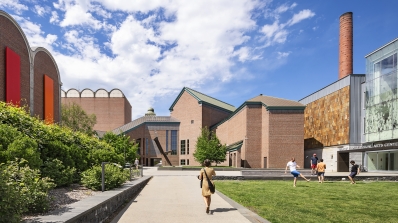Exhibitions Archive
The Abu Ghraib Project by Daniel Heyman
Bearing WitnessThe Philip H. Greene Gift of California Watercolors, 1930-1960
Coastline to Skyline
This exhibition celebrates the recent gift from Hanover resident Philip H. Greene of thirteen works by the California-style watercolorists. The mostly southern California artists who made up this informal but close-knit group were most active from the late 1920s through the 1950s. They achieved national recognition for their generally large-scale watercolors painted with broad, saturated washes in a manner that was bold and expressive, yet representational. Among the best known of the group were Millard Sheets, Phil Dike, Rex Brandt, Barse Miller, Emil Kosa Jr., and, from northern California, Dong Kingman. Just as their regionalist contemporaries Grant Wood and Thomas Hart Benton portrayed traditions associated with everyday life in the rural midwest, these artists celebrated their West Coast environs through images of the state's dramatic coastline, agricultural and fishing traditions, public amusements, and bustling cities. While many of the artists seem to pay homage in their work to a way of life that was disappearing in the face of urban development, others convey in their watercolors an appreciation for the modern Southland cityscape. In keeping with the populist, nationalistic mood of the era, these artists captured unpretentious, recognizably American subjects that transcended their regional content and appealed to audiences from coast to coast.
The Art of Ben Frank Moss
Immanence and Revelation
This exhibition of more than seventy paintings, drawings, and prints by Ben Frank Moss honors the artist’s twenty years at Dartmouth College, where he has served as chairman of the Studio Art Department and, since 1993, as the George Frederick Jewett Professor of Studio Art. Ranging from expansive, luminous landscapes inspired by Northwest summers to intimate, nearly abstract still lifes, these works reveal the artist’s fascination with lush color, essential forms, and an ineffable, enveloping presence beyond the subject at hand. The accompanying catalogue, which is the most comprehensive examination of Moss’s career to date, includes an extensive interview with the artist and an overview of his career written by former Moss student Joshua Chuang, Class of 1998, now an assistant curator at the Yale University Art Gallery.
Molas from Kuna Yala
Dressing Up Culture
Colorful, playful, and visually enticing, the appliquéd molas that Kuna women sew onto their blouses yield an astounding array of traditional and contemporary themes. These stitched cloth panels feature abstract and figurative motifs derived from Kuna legends and culture, political posters, labels, books, the natural world, mass media and popular culture, cartoons, and everyday life. Having initially developed from pre-Hispanic body arts, mola making in Kuna Yala, an archipelago that runs along the Caribbean coast of Panama, has become an important women’s economic enterprise that also preserves Kuna cultural and ethnic identity.
The Design Process and Details of the Hood Museum of Art
Taking a Look AroundImagining Classical Sculpture in Late-Nineteenth-Century Britain
Alma-Tadema and Antiquity
In conjunction with exhibitions in Naples, Italy, Washington, D.C., and Los Angeles, the Hood Museum of Art has developed a focused display centered on its most important nineteenth-century European, Sir Lawrence Alma-Tadema's (1836-1912) The Sculpture Gallery of 1874. While other venues emphasize the importance of the painting in the context of the artist's nostalgia for the past (the Museo Archeologico Natzionale in Naples) and the legacy of Pompeii and the Roman villa (the National Gallery of Art and the Los Angeles County Museum of Art), the Hood's "dossier exhibition" highlights the originality of the subject and its complex construction.


